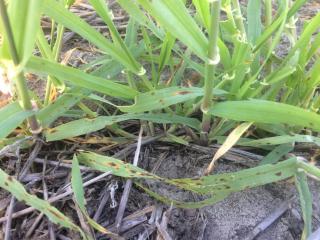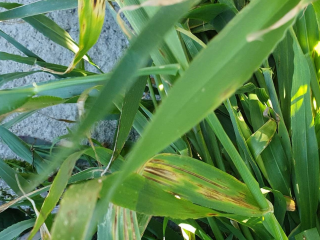Monitor barley crops for net blotches
Spot Form Net Blotch
- Kwinana north port zone (Nungarin, Muntadgin, Kalannie, Beacon, Wialki & Moorine Rock)
Net Form Net Blotch
- Albany region
- Esperance region
In early June Plant pathologists Kylie Chambers and Jason Bradley (DPIRD) reported finding spot form net blotch (SFNB) in Spartacus and Maximus barley in several locations across the Kwinana north zone.
Net form net blotch (NFNB) has recently been reported by several sources in RGT Planet in the Albany and Esperance port zones. DPIRD plant pathologist Kithsiri Jayasena has been seeing NFNB spores in spore traps for several weeks.
Two net blotches, spot form net blotch (SFNB) and net form net blotch (NFNB), occur in Western Australia and can be quite variable in appearance depending on the form of the pathogen, the variety of barley and the stage of infection.
Both SFNB and NFNB are stubble borne diseases, the fungus is carried from season to season on infested stubble. The closer new crops are sown to stubble, the greater the risk of infection occurring at early growth stages.
SFNB lesions develop as small circular or oval dark brown spots with yellow edges. Infections can occur following around six hours of leaf wetness at temperatures between 10-25°C. NFNB lesions appear on leaves as thin brown streaks or blotches that may enlarge up to several centimetres in length. For more information about diagnoses net blotches refer to DPIRD’s Diagnosing spot-type net blotch page and Diagnosing net-type net blotch page.
Barley varieties that are susceptible to SFNB (eg. Spartacus CL) or NFNB (eg. RGT Planet) that have not been treated with a fungicide seed dressing (ie Systiva®) or in-furrow (eg. Uniform®) registered against net blotches and are sown into in a high-risk situation (1-2 year old barley stubble) are particularly vulnerable. To see which barley varieties are susceptible to STNB and NTNB refer to DPIRD’s 2022 WA Crop Sowing Guide - Barley.
Managing net blotches and being mindful of resistance
Applying a fungicide spray is necessary in medium to high rainfall regions where disease threatens crops with high yield and quality expectations, particularly if the barley crop is a susceptible variety or has been sown into or adjacent to last year’s barley stubble.
Fungicides in three groups; Group 3 (DMI-demthylisation inhibitors), Group 11(Qol- quinone outside inhibitors) and Group 7 (SDHI-succinate dehydrogenase inhibitors) are registered to manage both diseases in WA. However, due to the presence of NFNB and SFNB populations resistant to some fungicides it is important to follow fungicide resistance management guidelines described in further detail below. At present, populations of both NFNB and SFNB have developed resistance to the DMI group of fungicides in WA. Resistance (SFNB) and reduced sensitivity (SFNB, NFNB) to SDHI fungicides has also been detected in WA over the last two years.
The choice of a single-spray or two-spray strategy depends on the presence of disease, the environment in which the crop is growing and the use of up-front fungicide at seeding. In high rainfall environments it may be necessary to apply one or two sprays, the first at early stem elongation stage if disease is at damaging levels already, with a follow-up spray three to four weeks later (Z33-45). Where up-front fungicides have been employed, such as seed dressing (e.g Systiva®) or in-furrow (e.g Uniform®), it is expected they will reduce or remove the requirement for a stem extension spray.
While in medium rainfall regions, or rotation crops, consider one well timed spray between late stem elongation and early flag leaf emergence (Z33 - 39) to protect leaf 2 (flag-1). Under high disease pressure best results may be obtained by using the maximum recommended rates.
Application of a registered foliar fungicide prior to stem extension (for example, tillering) can reduce disease levels after spraying but will not provide sufficient upper canopy protection and is likely to still require a follow-up fungicide later in the season. In low rainfall areas fungicide applications are most likely to result in a yield response to SFNB in earlier sown crops, when the disease pressure is high and there is reasonable spring rainfall or stored soil moisture.
Details on which foliar fungicide active ingredients are registered for SFNB and NFNB can be found at DPIRD's Registered foliar fungicides for cereals in Western Australia.
To date, fungicide resistance (for Group 3 or DMI actives such as prothioconazole, tebuconazole and epoxiconazole) has been found in populations of NFNB at Dandaragan (Geraldton Port Zone), South Stirling, Amelup, Tenterden, Kendenup (Albany Port Zone) and Scaddan (Esperance Port Zone). In addition, less sensitive NFNB pathogen populations are present at several locations across the wheatbelt. DMI resistance and reduced sensitivity in SFNB populations is widely distributed across most barley production regions in WA. Isolated occurrences of SDHI resistance in SFNB has been detected in central wheatbelt and Albany regions and reduced sensitivity to SDHI in NFNB also exists in Albany region.
To prevent further development of fungicide resistance it is recommended that growers; only use fungicide if necessary, rotate fungicides with different modes of action, avoid using the same mode of action twice per season, and use recommended label rates. It is also recommended that tebuconazole is not used as a stand-alone product, in barley for any other disease. For more information refer to the Australian Fungicide Resistance Extension Network (AFREN) Fungicide Resistance Management Guide .
For more information on fungicide resistance in WA net blotch populations see DPIRD’s Management of barley net blotches in the face of fungicide resistance and the Centre for Crop and Disease Management's (CCDM) article Fungicide resistance strategies: How much blotch until a paddock is botched?
If you suspect fungicide resistance in your paddock please contact the CCDM's fungicide resistance team at frg@curtin.edu.au .
For further information on symptoms and management of blotches see DPIRD’s Managing spot type net blotch in continuous barley and Managing net-type net blotch of barley in Western Australia pages.
For more information on blotches contact Plant Pathologists Andrea Hills, Esperance on +61 (0)8 9083 1144, Kithsiri Jayasena, Albany on +61 (0)8 9892 8477, Kylie Chambers, Northam on +61 (0)8 9690 2151 or Jason Bradley, South Perth on +61 (8) 9368 3982.
Article authors: Kithsiri Jayasena (DPIRD Albany), Geoff Thomas (DPIRD South Perth), Ciara Beard (DPIRD Geraldton), Andrea Hills (DPIRD Esperance) and Cindy Webster (DPIRD Narrogin).


